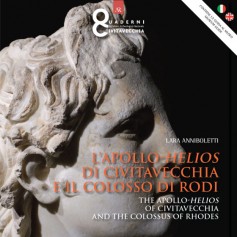L’Apollo-Helios di Civitavecchia

e il Colosso di Rodi
Il Colosso di Rodi, una delle sette meraviglie del mondo antico, è una delle opere più rappresentative del primo Ellenismo, innalzato dai Rodii dopo il terribile assedio del 304 a.C. conclusosi felicemente. La statua dedicata al dio del sole Helios, poi sintetizzato con Apollo, fu realizzata da Carete di Lindo, allievo del celebre Lisippo, lo scultore prediletto di Alessandro Magno.
Carete, con straordinaria capacità, riuscì a imprimere nella creazione lo slancio e l’energia di una città libera e innalzava al sole la fiaccola della vittoria.
Il Colosso, collocato su un molo del porto, cadde dopo circa sessanta anni a causa di un terribile terremoto, privandoci, a dispetto della sua grande fama, della sua reale iconografia.
La copia più completa della statua, realizzata in età adrianea, fu rinvenuta nell’area di una villa marittima a Santa Marinella, sul litorale a nord di Roma. L’eleganza e la leggerezza di questo capolavoro dell’arte antica, conservato al Museo Archeologico Nazionale di Civitavecchia, trasmettono oggi, come allora, una profonda emozione.
Al Museo Archeologico Nazionale di Civitavecchia – di cui in questo volume si offre una guida breve – oltre all’Apollo-Helios è esposta anche la copia dell’Athena, capolavoro del V secolo a.C. dell’artista ateniese Fidia.
The Colossus, one of the Seven Wonders of the ancient world, is one of the most well-known works of the early Hellenistic period, and was erected by the people of Rhodes following the terrible siege of 304 BC, which was eventually lifted.
The statue dedicated to the sun-god Helios, who later became merged with Apollo, was commissioned from Chares of Lindos, the pupil of the famous Lysippos, Alexander the Great’s favourite sculptor.
Showing extraordinary skill as a sculptor, Chares succeeded in imbuing his creation with the dynamism and energy of a city that had only just managed to liberate itself from a dire enemy, a city that now held aloft the beacon of victory to the sun.
The Colossus, whose base stood on one of the moles of the port, collapsed after around 60 years, owing to an earthquake. Despite its great fame, this deprived us of its real iconography: no statue is preserved. The most complete surviving copy of the statue was found among the remains of the maritime villa at Santa Marinella, on the coast north of Rome.
The elegance and lightness of this masterpiece of ancient art, held at the National Archaeological Museum of Civitavecchia, convey a deep emotion, then as now. Also on view at the National Archaeological Museum of Civitavecchia is a copy of the Athena Parthenos, a 5th century BC masterpiece by the Athenian artist Phidias A brief guide to the current museum display make this a volume packed with useful information.
Parole chiave
Questo libro lo trovi anche in: Archeologia
« Le vie cave in Etruria meridionale | Il ritorno della biga »











